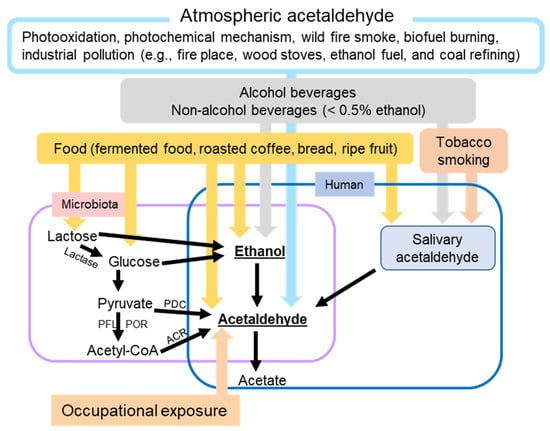You're using an outdated browser. Please upgrade to a modern browser for the best experience.
Please note this is a comparison between Version 1 by Zili Zhai and Version 2 by Conner Chen.
Acetaldehyde (AcAH) is a carcinogenic byproduct of ethanol metabolism. Ethanol-associated malignancies commonly occur in the upper gastrointestinal tract exposed to AcAH after ethanol ingestion. Unexpectedly but true, emerging epidemiological evidence supports a link between alcohol consumption and cutaneous melanoma, suggesting skin exposure to ethanol and AcAH as potential causes of skin cancer.
- melanoma
- ethanol
- acetaldehyde
1. Introduction
Melanoma is the most serious type of skin cancer, with an increasing incidence worldwide [1][2][1,2]. Cumulative evidence indicates that the risk of melanoma correlates with genetic factors [3][4][3,4], personal lifestyles [5][6][5,6], and phenotypic risk factors that reflect gene/personal lifestyle interactions [7][8][7,8]. Individual lifestyle factors associated with melanoma risk include UV exposure, cigarette smoking, alcohol use, overweight and obesity, poor diet, environmental pollution, and stress [5][6][5,6]. Nearly half (14 out of 29) of the studies on the relationship between alcohol consumption and melanoma, including 10 cohort and 19 case-control studies, have shown a positive correlation, while only 2 showed a negative correlation. Further, of 20 studies assessing alcohol dose effects, 13 (65%) demonstrated an association between alcohol dose and melanoma risk [9]. These associations became stronger in multiple meta-analyses with larger sample sizes [10][11][12][13][10,11,12,13]. A systematic meta-analysis by Gandini et al. found that individuals in the highest category of recent alcohol intake had a 30% increased risk of melanoma compared to those in the lowest category, and a nearly two-fold increased risk of melanoma was found with cumulative alcohol consumption [14].
Approximately 4% of cancer cases worldwide are caused by alcohol consumption [15]. The main culprit for this is acetaldehyde (AcAH), an immediate metabolite of ethanol. AcAH is a mutagen and carcinogen implicated in a wide range of cancers by forming adducts with proteins and DNA and disrupting cellular functions [16][17][16,17]. However, ethanol and AcAh are derived not just from alcohol drinking but from various sources, some of which exist naturally [18][19][18,19]. In fact, our skin is exposed to ethanol and AcAH every day, regularly at extremely low and safe levels [18][19][20][18,19,20]. While our skin, like the liver, is equipped with ethanol metabolism mechanisms to reduce the concentration of ethanol and AcAH [18][20][18,20], dysfunction of these ethanol and AcAH metabolizing enzymes in the skin may greatly influence the skin biology and increase the risk of ethanol/AcAH-associated skin diseases.
2. Exposure to Ethanol and AcAH
Humans are in a chemical and toxicological environment [21] and are exposed to ethanol and AcAH in many ways. Once in the bloodstream, ethanol and AcAH can reach many organs and tissues, including the skin [22]. The skin is also directly exposed to alcohols and aldehydes from natural chemicals or industrialized products [19][20][19,20].2.1. Sources of Ethanol
Ethanol is not only the active ingredient of alcoholic beverages (beers, wines, and spirits) but also is a ubiquitous substance from various sources (Figure 1). It is one of the main indoor and outdoor pollutants [19]. In addition to alcoholic beverages and air pollutants, non-alcoholic beverages on the market can contain as much as 0.5% ethanol [23]. Certain herbal medicines, including those used to treat coughs, colds, and gastrointestinal (GI) diseases, are also sources of ethanol [24]. Furthermore, many foods contain ethanol, which is produced from sugar through fermentation. Examples include fermented foods (i.e., bread, yogurt, vinegar, and kimchi), preservatives, bakery products, fruit, and fruit juices [25]. Brewers and bakers use yeast to make a variety of alcoholic beverages and expand the dough.
Figure 1. Schematic overview of the major factors leading to human skin exposure to ethanol and/or acetaldehyde. ACR, acetyl-CoA reductase; PDC, pyruvate decarboxylase; PFL, pyruvate formate-lyase; POR, pyruvate ferredoxin oxidoreductase.
